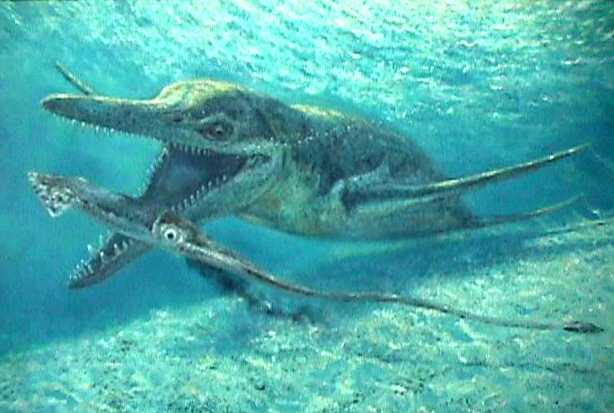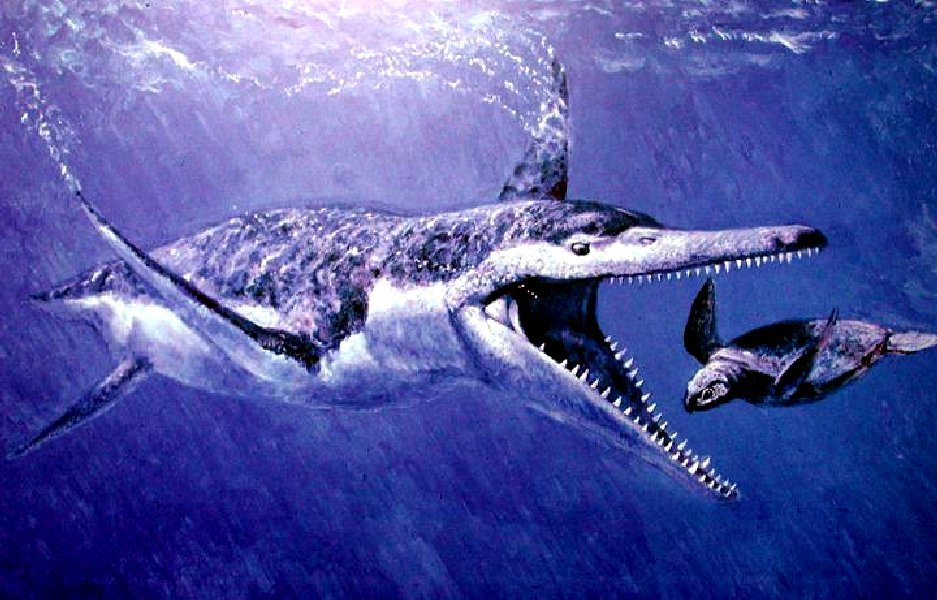


 The fiercest reptile ever to terrorise the oceans has been identified from a fossil on a frozen Arctic island. The huge pliosaur, dubbed The Monster, dated from 150 million years ago and boasted 60 dagger-like teeth the size of cucumbers, which it used to rip chunks out of prey. The 50ft (15m) animal was one of the biggest marine predators to have swum and it would have been able to take on “anything that moved” in the water.
The fiercest reptile ever to terrorise the oceans has been identified from a fossil on a frozen Arctic island. The huge pliosaur, dubbed The Monster, dated from 150 million years ago and boasted 60 dagger-like teeth the size of cucumbers, which it used to rip chunks out of prey. The 50ft (15m) animal was one of the biggest marine predators to have swum and it would have been able to take on “anything that moved” in the water.It was built for speed and power and with its armoury of fangs would have been rivalled in ferocity only by an extinct shark, the megalodon, which lived about 16 million years ago. Fossilised remains of the pliosaur, which had 10ft long jaws, were located on the Norwegian island of Svalbard, inside the Arctic Circle. It was one of 40 fossil creatures found close together on a mountain on Svalbard by a team of researchers from the University of Oslo Natural History Museum, in Norway. Jørn Hurum, who led the expedition, compared the animal to a “medium-sized blue whale with a threemetre-long crocodile skull”.
It was twice as big as a killer whale. The pliosaur, a type of plesiosaur, was the leading marine predator during the Jurassic Period and is thought to represent an unknown species. Its body was designed to minimise drag while its enormous flippers propelled it forward in a motion like flying through the water. A front flipper from The Monster was measured at almost 10ft long. Fossil bones from the specimen excavated last summer showed that it was almost 50 per cent bigger than the largest confirmed pliosaur, Kronosaurus, from Australia. An ichthyosaur, another marine predator, from 210 million years ago has previously been identified as being 75ft long but its teeth were much smaller than the pliosaur’s and it would have chased much smaller prey. Dr Hurum said: “The pliosaur was much, much fiercer.The ichthyosaur would have been an oversized fat dolphin by comparison. “This animal would have taken chunks out of anything that moved. It was the fiercest marine reptile and the biggest of its era. Its teeth and jaws could crush almost anything.”Dr Patrick Druckenmiller, a plesiosaur specialist at the University of Alaska Museum, was involved in the discovery.
He said: “Not only is this specimen significant in that it is one of the largest and relatively complete plesiosaurs ever found, it also demonstrates that these gigantic animals inhabited the northern seas of our planet during the age of dinosaurs.” In 2002 a fossil pliosaur from Mexico was nicknamed the Monster of Aramberri, amid claims that it was up to 65ft long. However, the measurements have yet to be confirmed. Angela Milner, associate keeper of palaeontology at the Natural History Museum, said the find illustrated how different the world was when the animal ruled the seas. “Svalbard was not so near the North Pole 150 million years ago, there was no ice-cap and the climate was much warmer than it is today.” She added: “There are a few isolated bones of huge pliosaurs already known but this is the first find of a significant portion of a whole skeleton of such a giant.” It has been suggested that the Loch Ness Monster could be a plesiosaur. Sceptics, however, have pointed out that the loch is 10,000 years old, whereas plesiosaurs are thought to have died out 65 million years ago.
No comments:
Post a Comment